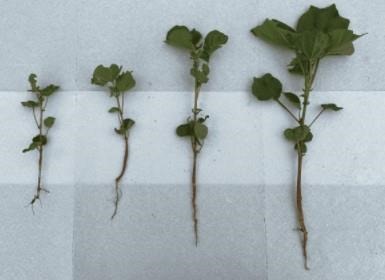At-Plant Insecticide Options
Insecticide seed treatments (ISTs) are currently the industry standard for thrips control, primarily because of the ease of application. However, under certain conditions, control is variable. If conditions are not conducive to seedling growth, particularly if nighttime temperatures are cool, seed treatments alone may not provide adequate control. Because of developing resistance, particularly to thiamethoxam, Extension professionals recommend seed be treated with an imidacloprid-based seed treatment. There are several brand names, and some include additional insecticides, but imidacloprid should be a component. Under light-to-moderate thrips pressure, ISTs may provide adequate control. Seed could also be treated with acephate (e.g., Orthene) or acephate could be added to imidacloprid. However, remember that in most cases a bag of over-treated cottonseed cannot be returned if not used.
Liquid or granular in-furrow insecticide applications are another at-plant option to manage thrips. These can be used to replace or supplement an IST. In many cases, in-furrow applications provide better control of thrips. However, using them requires extra equipment, proper calibration, and time when planting. Imidacloprid at the highest labeled rate has consistently provided good results in trials across Alabama in recent years. Acephate has provided more sporadic control, likely because of the wet springs the state has faced over the past two years that caused the chemical to leach out before the roots could uptake the needed amount to provide control. Aldicarb, now available as AgLogic15G, is another in-furrow option. This granular product provides excellent control of thrips and provides control of nematodes as well. Keep in mind that aldicarb is a restricted use pesticide, and additional training may be required to use this product.
Foliar Insecticides
Foliar insecticides may be needed to supplement at-plant treatments. However, foliar applications should never replace an at-plant insecticide. Thrips can injure seedling cotton until around the fifth true leaf stage. Research shows that foliar applications are usually most effective when made at the first true leaf stage. The Thrips Infestation Predictor for Cotton from North Carolina State University is a reliable tool that predicts the relative risk of thrips injury for cotton planted at a given location and planting date. To maximize the accuracy of the model, it should be run for several days before and after planting, as unpredicted weather patterns may alter the prediction. This tool should not be used to determine planting dates, but rather to help plan out fields or planting dates for cotton that will likely need a supplemental foliar application. Several options are available to use to supplement at-plant insecticides.

- Acephate (3 ounces per acre) is an effective and relatively inexpensive option. However, it has the potential to flare secondary pests, such as spider mites, and is the least rainfast of the available recommended options.
- Bidrin (3.2 ounces per acre) is another option that is effective and less likely to flare spider mites. It is also more rainfast than acephate, however it is more likely to cause crop injury when tank mixed with herbicides.
- Dimethoate (6.4 ounces per acre) is another cost effective and efficacious product with good rainfastness. However, it is the most likely to cause crop injury when tank mixed with herbicides.
- Intrepid Edge (3 ounces per acre) is another effective option. Intrepid Edge is less likely to flare secondary pests but may need the addition of a surfactant to help with efficacy.
Pyrethroids are not effective and should not be used to manage thrips.
Summary
Effective thrips control is critical to getting the 2022 crop off to a good start. When considering areas to cut back on costs, do not skip out on at-plant (IST or in-furrow) insecticides. Producers cannot manage thrips without having protection for the seedlings as soon as they emerge. If planting into cool, wet conditions, be prepared to make supplemental foliar sprays to help seed treatments get seedlings to the fifth true leaf stage.
Source : aces.edu